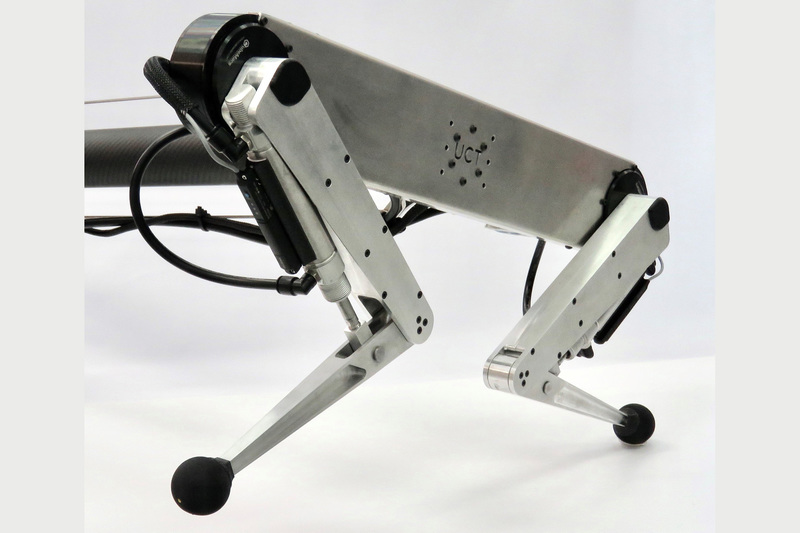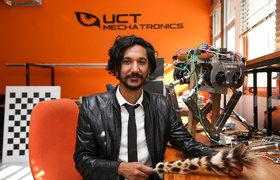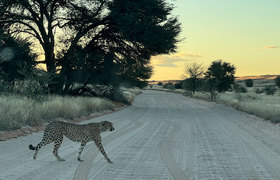African robotics developing in leaps and bounds
03 July 2023 | Story Natalie Simon. Photo Supplied. Read time 8 min.
The University of Cape Town’s (UCT) African Robotics Unit (ARU) has used an innovative new strategy, inspired by the movement of the cheetah, to allow for a powerful jumping movement in robots.
In 2009, the robotic Mars Rover Spirit got stuck in soft sand and was unable to free itself. National Aeronautics and Space Administration (NASA) had to hold a formal farewell for the robot just over a year later. “If only Spirit had been able to jump,” said Dr Reuben Govender, a senior lecturer in UCT’s Department of Mechanical Engineering. And that is why ARU at UCT’s Faculty of Engineering & the Built Environment has built a robot that is able to move in powerful bursts, like jumps, as well as being capable of finer and more controlled movement.
It is in this kind of powerful action that researchers at ARU recently made a breakthrough. As part of his master’s research, Christopher Mailer designed and built Kemba to experiment with the use of a pneumatic actuator, effectively a piston which uses pressurised air to produce a force. This is a deviation from standard practice in robotics, generally relying on the use of hydraulic actuators, which use hydraulic fluid or electric motors – allowing for much more controlled movement. This work was recently presented at the Institute of Electrical and Electronics Engineers International Conference on Robotics and Automation with a soon-to-be published paper titled “Getting Air: Modelling and Control of a Hybrid Pneumatic-Electric Legged Robot”.
“The opportunity to be part of building a robot that could move dynamically was very exciting to me as an engineer.”
“I started this research as part of my postgraduate studies after doing some vacation work in the ARU lab. The opportunity to be part of building a robot that could move dynamically was very exciting to me as an engineer, and I wanted to be part of taking that further,” said Mailer.
Revolutionary
The use of these pneumatic actuators is revolutionary in robotics because the movement produced is powerful but not finely controlled. This movement is inspired by the cheetah, which is not only the fastest terrestrial animal, but also the most manoeuvrable. This is why Associate Professor Amir Patel, the principal investigator (PI) at the ARU, has focused his research on this large cat, native to the continent.
“We have spent 10 years studying cheetah motion,” Associate Professor Patel explained. “When cheetahs accelerate, they are not really trying to do any kind of fine control of the force created by their feet, they are just pushing off as hard as they can. And this is how we came to the idea that maybe we should use an actuator that is explosive; that gives a very rapid amount of power.”
These actuators, placed at the knees of the robot, produced the effect the team were hoping for. The name of the African jumping robot is Kemba, based on inkemba, an isiZulu word for sword. While Kemba does cut through the air like a blade, it is also capable of finer controlled movement when necessary.
“One potential use case for robots is to send them into disaster situations with sensors and cameras, before any humans go into a dangerous situation,” explained Dr Govender, who, while not a member of the ARU, is a co-supervisor of the project. “If robots are doing this, they need to be able to move quickly and with bursts of power, jumping over fallen debris, for instance.”
Mailer, who was co-supervised by Patel, Govender and Dr Stacey Shield (based at the ARU), said: “It is useful to think about the way humans move, because it is the most relatable.
“There are periods, like when we are walking or running, where our limbs are just swinging freely without any fine control or thought. But that can quickly shift to fine, carefully controlled precision. This is what we are trying to achieve with Kemba.”
Entering new territory
For Patel, there are two avenues in terms of the importance of this work. The first is building a manoeuvrable robot that can handle difficult terrain, such that an agile robot can be put to work to any number of tasks. The second is using robotic systems as mechanical models to better understand the animals themselves.
But most importantly, he said, is the incredible and unanticipated value that comes from solving difficult problems.
“Studying the cheetah is really complex, partly because it is a difficult animal to study. You cannot just put sensors on it or monitor it in a laboratory, but also because the way it moves is so complex.”
“Biomedical research was not a field I ever thought I would make any impact in.”
Already the study of this remarkable animal has been a great driver of innovation. Patel said two patents have come out of his work studying the cheetah, with a possible third in the works. “One of the applications is in biomechanics,” he said, “and the other is in biomedical research. This was completely unexpected as biomedical research was not a field I ever thought I would make any impact in.”
UCT is also in the process of creating a spin-off company based on the innovation of the biomechanics patent.
“Deep technology spin-off companies, that is those based on science, health science and engineering technologies, are critical to increasing the number of jobs available for university graduates, growing local industry and preventing the loss of these skills to overseas markets where these jobs are more available,” said Andrew Bailey, the senior manager of innovation at Research Contracts & Innovation at UCT.
The advantage of geography
Cape Town offers researchers a real cutting edge in terms of geography. The ARU, currently a unit consisting of five UCT-based researchers, is using this geographical edge to be globally competitive, despite the relative lack of resources.
“I am so fortunate that I can travel 20 minutes down the N2 to put sensors down to study cheetah motion,” said Patel. “This blows the minds of my colleagues in the developed world who have never even seen a cheetah.”
The strategic use of this competitive edge is the reason researchers in the ARU can build a globally competitive reputation for their robotics work.
“We are the people who live in the same country as the cheetah and other incredible animals – let’s just do it with whatever resources we have.”
The cheetah is not their only research focus. Members of the team are studying a diverse range of questions all leveraging the advantage of the southern location. Patel’s co-PI, Paul Amayo, is working on autonomous vehicle technology, but particularly how that applies to the different road conditions and terrain in Africa. The team’s other research projects include marine robotics, particularly in the southern oceans, and work on 5G and communications.
Dr Shield completed her PhD within ARU on the use of mathematical modelling to simulate cheetah movement and motion. For her, ARU is an incredibly Afro-positive initiative because it demonstrates how, even with limited resources, such incredible innovation can emerge from the continent.
“I love that we did not just cede the cutting edge [research] to richer universities,” she said. “Instead, we said no, we are the people who live in the same country as the cheetah and other incredible animals – let’s just do it with whatever resources we have.”
Next steps
For Kemba, the future is bright. Patel and the team have plans to expand the robot’s range of movement even further.
“Possible next steps include working on a spine to increase the robot’s mobility – and in time, maybe even a tail,” Patel said.
 This work is licensed under a Creative Commons Attribution-NoDerivatives 4.0 International License.
This work is licensed under a Creative Commons Attribution-NoDerivatives 4.0 International License.
Please view the republishing articles page for more information.
Related










